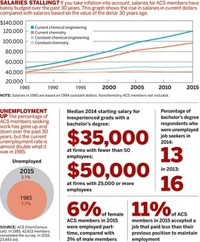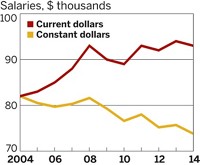Advertisement
Grab your lab coat. Let's get started
Welcome!
Welcome!
Create an account below to get 6 C&EN articles per month, receive newsletters and more - all free.
It seems this is your first time logging in online. Please enter the following information to continue.
As an ACS member you automatically get access to this site. All we need is few more details to create your reading experience.
Not you? Sign in with a different account.
Not you? Sign in with a different account.
ERROR 1
ERROR 1
ERROR 2
ERROR 2
ERROR 2
ERROR 2
ERROR 2
Password and Confirm password must match.
If you have an ACS member number, please enter it here so we can link this account to your membership. (optional)
ERROR 2
ACS values your privacy. By submitting your information, you are gaining access to C&EN and subscribing to our weekly newsletter. We use the information you provide to make your reading experience better, and we will never sell your data to third party members.
Salaries
What US chemists made before the COVID-19 pandemic, according to the 2020 ACS salary survey
Overall salaries were flat for members, but some groups saw increases from 2019
by Andrea Widener
February 1, 2021
| A version of this story appeared in
Volume 99, Issue 4

Credit: C&EN/Shutterstock














Like many events in 2020, the American Chemical Society salary survey was delayed by the COVID-19 pandemic. Normally conducted in the spring, the survey collected data in June and July of last year. The data shown here reflect the median annual salaries for 4,565 ACS members under age 70 who work as full-time employees in the US. (ACS publishes C&EN.)
The most notable change from the 2019 survey is the drop in unemployment rate. The salary survey shows an unemployment rate of 1.5% for ACS members, who were asked to report their status as of March 1, 2020. That’s down more than a point from the 2019 rate and is the lowest rate in the past 20 years. Unemployment in some regions dropped to below 1%.
Why the big drop? C&EN asked ACS its thoughts about the change and what might be causing it.
To start, there’s the date: March 1 was before most people would have felt the economic effects of COVID-19. “I would point to the rise in the economy and how our economy’s been doing in general prior to the pandemic,” says Eric Bruton, a chemist at Boeing and chair of the ACS Committee on Economic and Professional Affairs (CEPA), which oversees the salary survey. He points in particular to growth in several chemical-related industries during late 2019 and early 2020. “Overall, it’s a nice positive.”
Steven Meyers, who oversees the salary survey as ACS’s senior director of member programming, says the low employment rate “is emblematic of a trend that we’ve been seeing since the end of the last recession” in 2008–9, reflecting more than 10 years of economic growth.
The drop in unemployment in the ACS survey data isn’t reflected in the US unemployment rate in March for people with at least a bachelor’s degree, which was up slightly from 2.0% in March 2019 to 2.5% in March 2020, according to the US Bureau of Labor Statistics. ACS often uses this number to compare trends for ACS members with the larger economy.
But Meyers points out that the ACS salary survey “is not of the entire US economy. It’s not of global chemists. It’s not even of US chemists. It’s a measure of the membership.” The ACS survey unemployment rate doesn’t include students, members over 70, or international members, Meyers says. In addition, ACS members are more likely to have a PhD and work in academia than US bachelor’s degree recipients. Those groups tend to have better employment outcomes.
ACS calculated a margin of error of ±1.45 percentage points for the unemployment rate, which could put the real unemployment at almost 0 or up to 3%, Meyers says.
ACS expects to see ACS member unemployment increase in 2021 as a result of the pandemic. Bruton encourages unemployed ACS members to use services such as career counseling, webinars, and dues waivers for people experiencing hardship because of the pandemic.
Note for all data: Data are from 4,565 American Chemical Society members’ survey responses collected from June 1 to July 14, 2020, except when other years’ data are shown. Salaries reflect the median annual salaries on March 1 for full-time US employees who say their work specialty is chemistry, except for the comparison between chemists and chemical engineers, which includes data from full-time US employees who say their work specialty is chemical engineering. Numbers do not include students, members over 70, or international members.
Salary breakdown by demographics
Overall salaries were flat compared with 2019

Salaries have increased since 1985 when viewed in current dollars

Note: Current dollars are the value in the year the salary was reported. Data are missing for 2017 and 2018 because of changes to the survey. For more explanation see the 2019 salary report at cenm.ag/salarysurvey2019.
But salaries have been almost flat when adjusted for inflation

Note: Salaries were adjusted for inflation using 1985 as the base year. Data are missing for 2017 and 2018 because of changes to the survey. For more explanation see the 2019 salary report at cenm.ag/salarysurvey2019.
Chemical engineers made more than chemists

Men made significantly more than women

Asian respondents earned the highest salaries

Note: Respondents could choose more than one race and could additionally denote their Hispanic/Latino identity in response to a separate question. Salaries for Native Americans and Pacific Islanders are not reported because of the small number of people who responded in those categories.
Salary breakdown by region
Salaries continue to vary widely by region. In some cases bachelor's degree recipients made more than those with a master's degree
Unemployment
Unemployment for ACS members fell drastically in 2020 right before the pandemic started to affect the economy
Unemployment was highest for ACS members with only a bachelor's degree

Note: Numbers reflect unemployment status as of March 1 in the indicated year.
Who took the survey?
These are the US ACS members who took the 2020 survey
More respondents worked in academia than industry

Most had a doctoral degree

Most respondents were native US citizens

Most respondents were men

Respondents were predominantly white

Note: Numbers do not add to 100% because respondents could choose more than one race and could additionally denote their Hispanic/Latino identity in response to a separate question.
The largest proportion of respondents were 45–54 years old, with an average age of 42.6

Only a small fraction identified themselves as disabled
These are the top 10 industries in which respondents worked

Those in educational fields worked in a variety of jobs, with more men in faculty positions






Join the conversation
Contact the reporter
Submit a Letter to the Editor for publication
Engage with us on Twitter